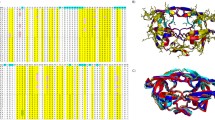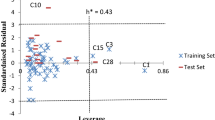Abstract
Our ongoing efforts to understand the difference in the binding pattern of HIV-1 protease inhibitor (HIVPI) with the wild-type and mutant HIV-1 protease (HIVPR) and to provide mechanistic insight are continued further. We report here the results of a recent quantitative structure–activity relationship (QSAR) study on monoindazole-substituted P2 analogues of cyclic urea HIVPIs. The QSAR models revealed an inverted parabolic relationship between biological activity and calculated molar refractivity (CMR). That is, biological activity first decreases with increase in CMR and at a certain minimum point (inversion point) it suddenly changes and increases with further increase in CMR. CMR is a measure of volume-dependent-polarizability and is an indication of the polar interactions between ligand and receptor. The results seem to be best rationalized by larger molecules inducing a change in a receptor unit that allows for a new mode of interaction. Similar QSAR models were also observed for the biological activity of these molecules tested against a panel of mutant viruses including mutant strains with single amino acid substitution (I84V), double amino acid substitutions (I84V/V82F), and multiple amino acid changes corresponding to mutations observed in clinical isolates of patients treated with Ritonavir®. Interestingly the inversion points for these mutant strains were found larger than for wild-type. The subtle but significant difference in the inversion point indicates change in the shape and size of the binding pocket. Earlier QSAR studies have shown that the correlation of biological activity with an inverted parabola is an indicative of the ‘allosteric interaction’ of the ligands with the receptor. This report presents a detail analysis of these observations.

Similar content being viewed by others
References
Chrusciel RA, Strohbach JW (2004) Curr Top Med Chem 4:1097
Gulick RM (2003) Clin Microbiol Infect 9:186
van Heeswijk RP, Veldkamp A, Mulder JW, Meenhorst PL, Lange JM, Beijnen JH, Hoetelmans RM (2001) Antivir Ther 6:201
Turner D, Schapiro JM, Brenner BG, Wainberg MA (2004) Antivir Ther 9:301
Mehandru S, Markowitz M (2003) Expert Opin Investig Drugs 12:1821
(a) Fujita T (1997) Quant Struct-Act Relat 16:107; (b) Yang GF, Huang X (2006) Curr Pharm Des 12:4601
Walters WP, Murcko MA (2002) Adv Drug Deliv Rev 54:255
(a) Jorgensen WL, Duffy EM (2002) Adv Drug Deliv Rev 54:355; (b) Abdel-Rahman HM, Al-karamany GS, El-Koussi NA et al (2002) Curr Med Chem 9:1905
(a) Hansch C, Leo A, Mekapati SB, Kurup A (2004) Bioorg Med Chem 12:3391; (b) Luco JM, Marchevsky E (1999) J Chem Inf Comput Sci 39:396
(a) Garg R, Gupta SP, Gao H, Mekapati SB, Debnath AK, Hansch C (1999) Chem Rev 99:3525; (b) Kurup A, Garg R, Hansch C (2001) Chem Rev 101:2573
(a) Kurup A, Mekapati SB, Garg R, Hansch C (2003) Curr Med Chem 10:1819; (b) Debnath AK (2005) Curr Pharm Des 11:3091; (c) Gayathri P, Pande V, Sivakumar R, Gupta SP (2001) Bioorg Med Chem 9:3059
Bhhatarai B, Garg R (2005) Bioorg Med Chem 13:4078
Patel D, Garg R (2005) Bioorg Med Chem Lett 15:3767
De Lucca GV, Kim UT, Liang J, Cordova B, Klabe RM, Garber S, Bacheler LT, Lam GN, Wright MR, Logue KA, Erickson-Viitanen S, Ko SS, Trainer GL (1998) J Med Chem 41:2411
(a) Hansch C, Garg R, Kurup A, Mekapati SB (2003) Bioorg Med Chem 11:2075; (b) Hansch C, Garg R, Kurup A (2001) Bioorg Med Chem 9:283
(a) Mekapati SB, Hansch C (2001) Bioorg Med Chem 9:2885; (b) Garg R, Kurup A, Hansch C (2001) Bioorg Med Chem 9:3161; (c) Christopoulos A (2002) Nat Rev Drug Discov 1:198
Lam PYS, Ru Y, Jadhav PK, Aldrich PE, De Lucca GV, Eyermann CJ, Chang C-H, Emmett G, Holler ER, Daneker WF, Li L, Confalone PN, McHugh RJ, Han Q, Markwalder JA, Seitz SP, Bacheler LT, Rayner MM, Klabe RM, Shum L, Winslow DL, Kornhauser DM, Jackson DA, Erickson-Viitanen S, Sharpe TR, Hodge CN (1996) J Med Chem 39:3514
Cramer RD III, Bunce JD, Patterson DE, Frank IE (1988) Quant Struct-Act Relat 7:18
CQSAR program, Biobyte Corp., 201 W. 4th street, Claremont, CA 91711
Leo A (1993) Chem Rev 93:1281
(a) Hansch C, Leo A (eds) (1995) Exploring QSAR: fundamentals and applications in chemistry and biology. American Chemical Society, Washington; (b) Hansch C, Leo A, Hoekman D (eds) Exploring QSAR: hydrophobic, electronic and steric constants. American Chemical Society, Washington
Garg R, Bhhatarai B (2004) Bioorg Med Chem 12:5819
(a) Koshland DE Jr (1958) Proc Natl Acad Sci USA 44:98; (b) Koshland DE Jr, Boyer PD (eds) (1970) The enzymes, vol 1. Academic Press, New York, p 342
(a) Hansch C, Klein T (1986) Acc Chem Res 19:392; (b) Kubinyi H (ed) (1993) QSAR: Hansch analysis and related approaches. VCH, New York
(a) Monod J, Changeux J-P, Jacob F (1963) J Mol Biol 6:306; (b) Monod J, Wyman J, Changeux J-P (1965) J Mol Biol 12:88
(a) Toh H, Ono M, Saigo K, Miyata T (1985) Nature 315:691; (b) Miller M, Jaskolski M, Rao JKM, Leis J, Wlodawer A (1989) Nature 337:576
McCammon JA (2005) Biochim Biophys Acta 1754:221
(a) Perryman AL, Lin J-H, McCammon JA (2004) Protein Sci 13:1108; (b) Perryman AL, Lin J-H, McCammon JA (2006) Chem Biol Drug Des 67:336; (c) Perryman AL, Lin J-H, McCammon JA (2006) Biopolymers 82:272
Hornak V, Simmerling C (2007) Drug Discov Today 12:132
Babine RE, Bender SL (1997) Chem Rev 97:1359
Appelt K (1993) Perspect Drug Discov Des 1:23
Gunasekaran K, Ma B, Nussinov R (2004) Proteins 57:433
Acknowledgements
This study was supported by grant 2 R15 GM 069323-02 from NIH/NIGMS. The authors are indebted to Biobyte Corp., Claremont, CA for the use of CQSAR program.
Author information
Authors and Affiliations
Corresponding author
Rights and permissions
About this article
Cite this article
Garg, R., Bhhatarai, B. Possible allosteric interactions of monoindazole-substituted P2 cyclic urea analogues with wild-type and mutant HIV-1 protease. J Comput Aided Mol Des 22, 737–745 (2008). https://doi.org/10.1007/s10822-008-9210-y
Received:
Accepted:
Published:
Issue Date:
DOI: https://doi.org/10.1007/s10822-008-9210-y




